
The alternative social media platform Telegram has served as an important tool for journalists and civilians in conflict zones. However, the platform hasn’t gone without its share of controversy. It has been pressured to remove “far-right” content in Germany and has banned pro-ISIS channels in Indonesia in response to government threats to ban the app there.
Telegram exists in a crowded social media universe, where many newer social media sites explicitly present themselves as alternatives to more established platforms, especially by opposing free speech restrictions they say are found on other sites. While Telegram says it supports free speech, it does not claim to be opposed to censorship.
An October 2022 Pew Research Center study took a close look at Telegram and six other alternative social media platforms that have created small but generally satisfied communities of news consumers: BitChute, Gab, Gettr, Parler, Rumble and Truth Social. Telegram is distinct from the other six alternative social media sites in this group in that it uses a chat model and does not have an aggregated feed. Instead, users can join individual channels and groups to view content there.
Here are a few key facts about Telegram and its users, based on the Center’s recent study.
This Pew Research Center analysis provides data about Telegram. It is based on an October 2022 Center study that examined Telegram and six other alternative social media platforms – BitChute, Gab, Gettr, Parler, Rumble and Truth Social – using a multi-method approach. Sites were included in the study if they had publicly accessible posts, were mentioned in news media, and had at least 500,000 unique visitors in December 2021.
The survey portion of the study was conducted May 16-22, 2022, among 10,188 U.S. adults. Everyone who completed the survey is a member of Pew Research Center’s American Trends Panel (ATP), an online survey panel that is recruited through national, random sampling of residential addresses. This way nearly all U.S. adults have a chance of selection. The survey is weighted to be representative of the U.S. adult population by gender, race, ethnicity, partisan affiliation, education and other categories. Read more about the ATP’s methodology here. Respondents were asked about their familiarity with each of the seven social media sites studied. Those who reported having heard of these sites were also asked whether they use the sites and get news there, how they feel about them, and more.
The margin of sampling error for the full sample of 10,188 respondents is plus or minus 1.6 percentage points; the margin of sampling error for the 587 alternative social media news consumers is plus or minus 7.0 percentage points; and the margin of sampling error for the 234 Telegram news consumers is plus or minus 11.5 percentage points.
The audit of alternative social media sites was initially conducted in April 2022. To conduct the analysis, a team of researchers were trained on a set of variables that examined features of each site, like its privacy and moderation policies. Researchers reexamined each site from August to September 2022 (Telegram was also rechecked in December 2022) and updated findings with any changes.
The account content analysis examines a sample of 200 prominent accounts on each of the seven sites included in this analysis, for a total of 1,400 examined accounts. Prominent accounts were sampled from the top 5% of accounts with the greatest number of followers on each site. A team of trained researchers analyzed these 1,400 sampled accounts to determine who runs the account, their political orientation, values, and other characteristics. For more details on how accounts were identified and sampled, read the methodology.
The content analysis of posts examines the topics discussed and sources cited in 585,470 posts published in June 2022 by the 1,400 sampled accounts (only 1,147 of these accounts posted at least once that month). Researchers used a set of unique keywords to identify posts about five distinct topics – abortion; guns, gun control and shootings; the Jan. 6 attack on the U.S. Capitol; LGBTQ issues; and vaccines. Researchers looked at unique two- and three-word phrases that were commonly used in posts on each topic. Researchers then examined the unique domains linked to in these posts to identify the types of sources these accounts were using.
Here are the questions used in the study, detailed tables, and the methodology.
Pew Research Center is a subsidiary of The Pew Charitable Trusts, its primary funder. This is the latest report in Pew Research Center’s ongoing investigation of the state of news, information and journalism in the digital age, a research program funded by The Pew Charitable Trusts, with generous support from the John S. and James L. Knight Foundation.
- While 27% of U.S. adults say they have heard of Telegram, only 2% use the app for news. Overall, just 6% of Americans regularly get news from at least one of the seven alternative social media sites studied, and no single site is regularly used for news by more than 2% of U.S. adults. Greater shares of Americans use more established sites for news, including Facebook (31%), YouTube (25%) and Twitter (14%).
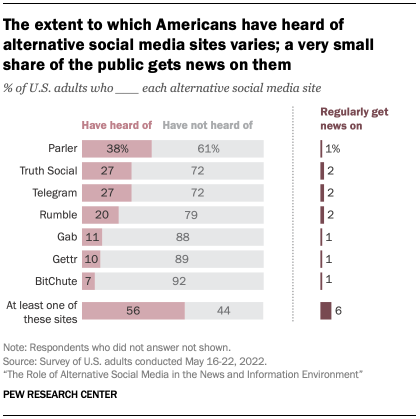
- Telegram identifies itself as a platform for free speech – but does not explicitly claim to be an alternative to Big Tech. Telegram, like the other six alternative social media platforms the Center studied, says it supports free speech or the First Amendment. But unlike some of the other platforms examined, it does not claim to be an alternative to Big Tech nor claim to be opposed to censorship.
- Few prominent Telegram accounts identify as right-leaning or pro-Donald Trump in their profiles. The Center’s study looked at 200 prominent accounts on Telegram, selected from a list of accounts with the most followers. As of June 2022, about one-in-ten of these accounts (11%) have a reference to being right-leaning or pro-Trump in their profile – a smaller share than on four of the other alternative social media platforms studied. In addition, 7% of these prominent Telegram accounts express a religious identity, and 5% have a reference to patriotism or a pro-America message in their profile.
Many of these 200 accounts (56%) are individuals while 33% are organizations. And about three-in-ten of these accounts (29%) have values or other appeals in their profiles.
- Many of those who regularly get news on Telegram report having positive experiences. Among the 2% of U.S. adults who regularly get news on Telegram, 75% say they expect the news and information there to be mostly accurate, while 24% expect it to be mostly inaccurate. Around seven-in-ten Telegram news consumers (68%) say the news they got there helped them better understand current events, while 11% say it made them more confused about current events.
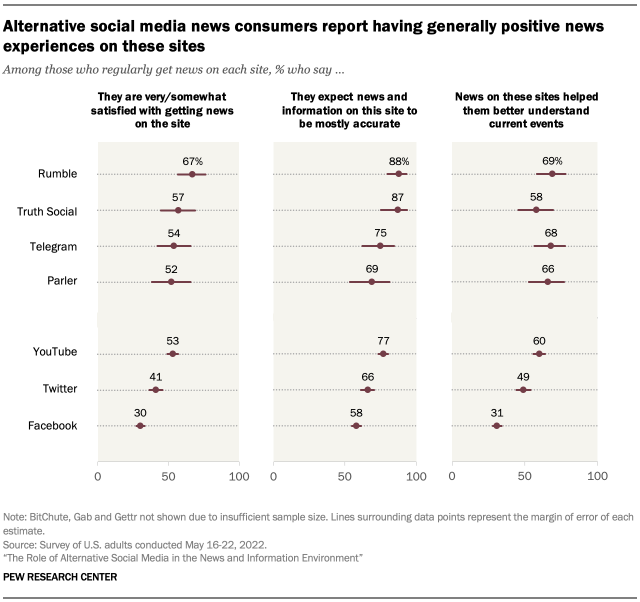
A large share of those who regularly get news on Telegram (54%) say they are very or somewhat satisfied with the experience, while 10% are very or somewhat dissatisfied and the rest give a neutral assessment. Additionally, 53% of news consumers say the discussions they see on the app are mostly friendly, while 21% see mostly unfriendly discussions and 21% say they see about an equal mix of friendly and unfriendly discussions.
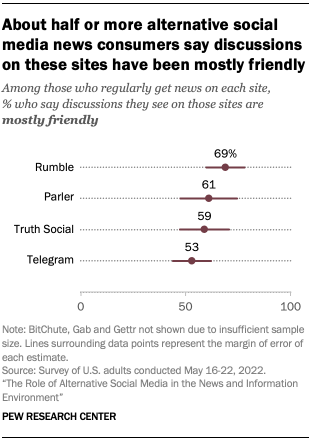
- Significant shares of the prominent Telegram accounts studied posted about guns, LGBTQ issues and vaccines in June 2022. A review of posts from these 200 prominent Telegram accounts found that 57% posted about guns and gun rights in June 2022, 48% posted about LGBTQ issues, 42% posted about vaccines, 42% posted about abortion and 30% posted about the Jan. 6 attack on the Capitol. (These posts came amid widespread discussion of several high-profile shootings, LGBTQ issues and vaccinations. The Supreme Court’s decision to overturn Roe v. Wade and a U.S. House committee investigating the Jan. 6 Capitol riot were also regularly in the news at the time.)
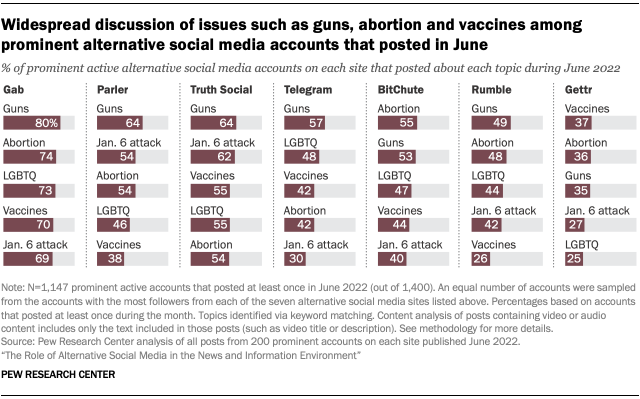
- About two-thirds (66%) of those who regularly get news from any of the seven alternative social media sites studied by the Center – including Telegram – identify as Republican or lean toward the Republican Party. This is far greater than the share who identify as Democrats or lean Democratic (33%). By comparison, those who get news on at least one of three more established social media sites studied by the Center – Facebook, Twitter and YouTube – are more likely to be Democrats or Democratic-leaning than Republican or Republican-leaning.
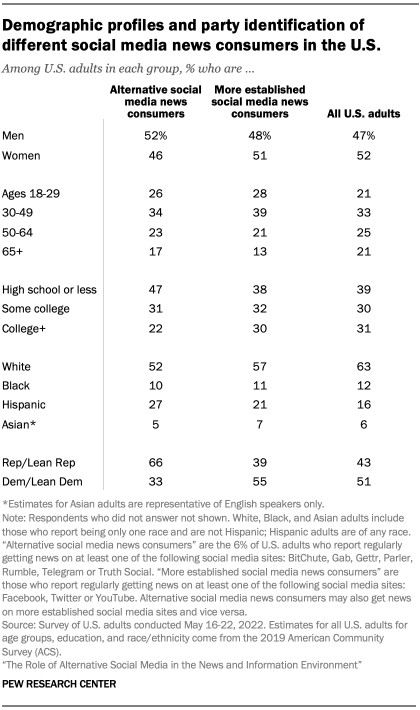
Note: Here are the questions used in the study, detailed tables, and the methodology.

